Cycling the Normandy D-Day beaches (part 2)
Please click here to go back to the first part of 'Operation Overlord' trip to Normandy.
Day 5- Bayuex to Carentan (42 miles)
It’s going to be a long day today, and tight on times if I'm to see all I
planned. I left Bayeux on the 'Ru De Dr Michael road' past the Botanical
Gardens on the D6, a long straight road. Turning left a few miles later to
follow the La Drome River for a mile
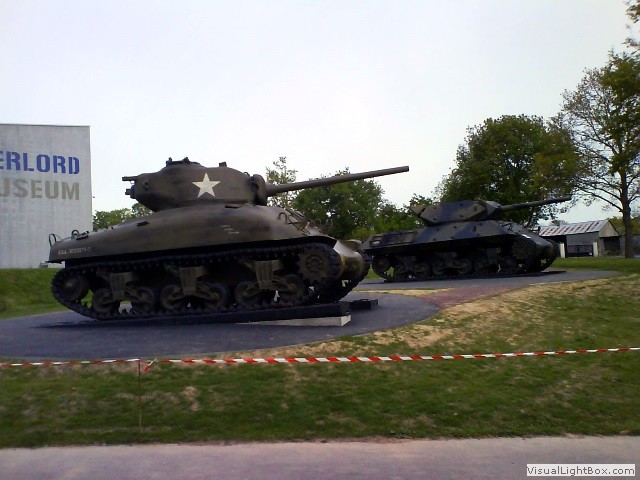 and then turn North West heading for the 'Big Red One' a museum at Colleville sur Mer. The
Big Red One is a little museum, with poignant artefacts collected by the enthusiastic and
extremely knowledgeable owner; worth popping in. Next, and no more than a few hundred yards
away is 'Overlord Museum'. The first thing to notice are the tanks outside, it isn't a huge
museum which suits me on this trip. I entered the museum and asked for somewhere to store the
bike, they were polite, but there was nowhere, so again I couldn't visit.
and then turn North West heading for the 'Big Red One' a museum at Colleville sur Mer. The
Big Red One is a little museum, with poignant artefacts collected by the enthusiastic and
extremely knowledgeable owner; worth popping in. Next, and no more than a few hundred yards
away is 'Overlord Museum'. The first thing to notice are the tanks outside, it isn't a huge
museum which suits me on this trip. I entered the museum and asked for somewhere to store the
bike, they were polite, but there was nowhere, so again I couldn't visit.
Just down the road was the Normandy American Cemetery (Cimetière Américain
de Normandie). Again I rode to the reception and asked for somewhere secure to
store the bike, they were extraordinary rude and were hubristic. The car park was
the size of a small amusement park, full of tour coaches, private tour mini-busses
and the bike racks were in the middle of it. This time I reluctantly locked the bike
up and went in- the Cemetery was simply too important to miss. I appreciate the scale
of the cemetery, and its exposure to films and media are always going to attract a
multitude of visitors, but it really did seem like we were queueing for a Disneyland-esque
tourist-attraction. Inside, the graves were roped off, there was no walking on the grass
and the 'American National anthem'
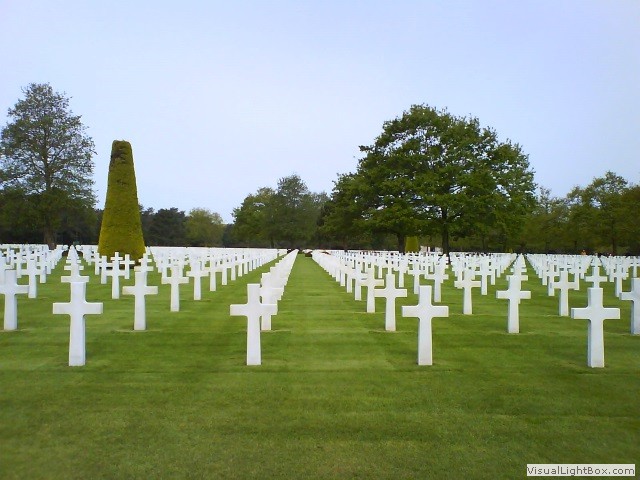 was piped out in-between the 'Last Post'. I must admit I felt uneasy about the gaudiness
of this consecrated ground, mingling with bus loads of children mucking about, clearly not
aware of the gravity of where they were, but to me standing between the endless symmetrical
lines of crosses the reality of the sacrifice sets in. There's just short of 10,000 American
soldiers laid to rest here, but I left the burial ground disappointed, with not a single
soldiers name in my mind (because they were caged off behind ropes and too far away to read),
it felt like a corporatised park full of white crosses.
was piped out in-between the 'Last Post'. I must admit I felt uneasy about the gaudiness
of this consecrated ground, mingling with bus loads of children mucking about, clearly not
aware of the gravity of where they were, but to me standing between the endless symmetrical
lines of crosses the reality of the sacrifice sets in. There's just short of 10,000 American
soldiers laid to rest here, but I left the burial ground disappointed, with not a single
soldiers name in my mind (because they were caged off behind ropes and too far away to read),
it felt like a corporatised park full of white crosses.
I left the Cemetery on the north east side and headed down sand dunes to the Croix de Guerre 5th Engineer Special Brigade and across the dip is 'WN 61'. The site has a few gun casemates and trenches strangely intertwined with a few seaside holiday chalets. It's a good 30 minute walk now across Omaha beach, the beach was deserted and was harder walking along than I imagined. I popped up on the Rue Bernard Anquetil road where there was a few more bunkers (not listed on the Google maps). ½ mile inland is 'Musee Memorial Omaha Beach', then back to the beach road where I came across Omaha beach- Sector Charlie & Dog Green where there's touching monument depicting a soldier dragging a comrade off the beach.
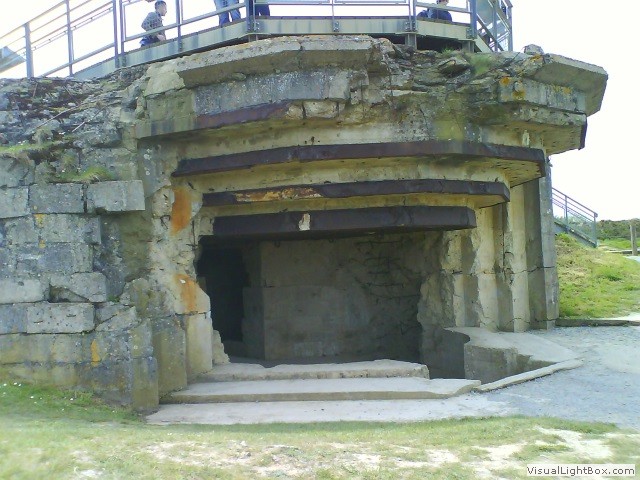 Six miles west from the centre of Omaha Beach was the alleged big naval guns of 'La Pointe Du Hoc',
Americas No.1 target for destruction during D-Day. At 0550, naval bombardment of Pointe du Hoc began;
by 0710 the 2nd Ranger Battalion soldiers had scaled the cliff, and despite fierce resistance, the
Rangers had enough numbers to take the emplacement by 0910. The task was incredible, especially seeing
how high the cliffs are from the beach, but the story doesn't stop there. In the last decade, evidence
had come to light to suggest there were no big guns at La Pointe Du Hoc during D-Day (something the
veterans of the 2nd Ranger Battalion clarified many years after). Today the site has been commercialised,
but the grassed over land can't disguise the heavy bombardment of the place, the ferocity of the Allied
shelling is easily visible today with craters as deep as houses pot marking the ground.
Six miles west from the centre of Omaha Beach was the alleged big naval guns of 'La Pointe Du Hoc',
Americas No.1 target for destruction during D-Day. At 0550, naval bombardment of Pointe du Hoc began;
by 0710 the 2nd Ranger Battalion soldiers had scaled the cliff, and despite fierce resistance, the
Rangers had enough numbers to take the emplacement by 0910. The task was incredible, especially seeing
how high the cliffs are from the beach, but the story doesn't stop there. In the last decade, evidence
had come to light to suggest there were no big guns at La Pointe Du Hoc during D-Day (something the
veterans of the 2nd Ranger Battalion clarified many years after). Today the site has been commercialised,
but the grassed over land can't disguise the heavy bombardment of the place, the ferocity of the Allied
shelling is easily visible today with craters as deep as houses pot marking the ground.
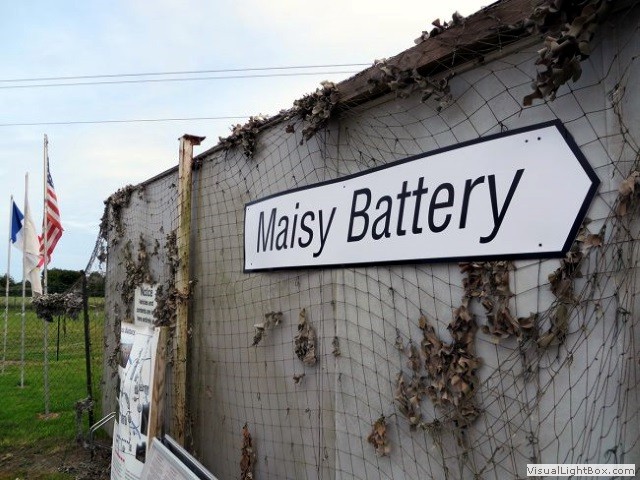 I turned inland at 'Grandcamp Maisy' to visit the Maisy Battery (click the image for more), one of the largest German
defensive positions in the Omaha sector. Maisy Battery doesn't have a visitor centre, no coffee
shop, even the car park is smaller than a tennis court, there's no coaches or many cars, but boy
does this place have a 'sting in the tail' story to tell. Over ⅔ of the site isn't excavated
yet with a predicted two miles of original German trenches still intact. Maisy battery was only
uncovered in 2006, after being obliterated from historical accounts by deliberately burying the site
under one metre of soil and losing historical accounts of the site amidst sixty years of secrecy
laws hosted by the USA and Great Britain. I walked from bunker after bunker around this astonishing
untarnished site. Maisy has original German guns in place, and it's spine tingling to stand where
German gunners once would have stood as they fired at the invasion forces up to three days
after D-Day.
I turned inland at 'Grandcamp Maisy' to visit the Maisy Battery (click the image for more), one of the largest German
defensive positions in the Omaha sector. Maisy Battery doesn't have a visitor centre, no coffee
shop, even the car park is smaller than a tennis court, there's no coaches or many cars, but boy
does this place have a 'sting in the tail' story to tell. Over ⅔ of the site isn't excavated
yet with a predicted two miles of original German trenches still intact. Maisy battery was only
uncovered in 2006, after being obliterated from historical accounts by deliberately burying the site
under one metre of soil and losing historical accounts of the site amidst sixty years of secrecy
laws hosted by the USA and Great Britain. I walked from bunker after bunker around this astonishing
untarnished site. Maisy has original German guns in place, and it's spine tingling to stand where
German gunners once would have stood as they fired at the invasion forces up to three days
after D-Day.
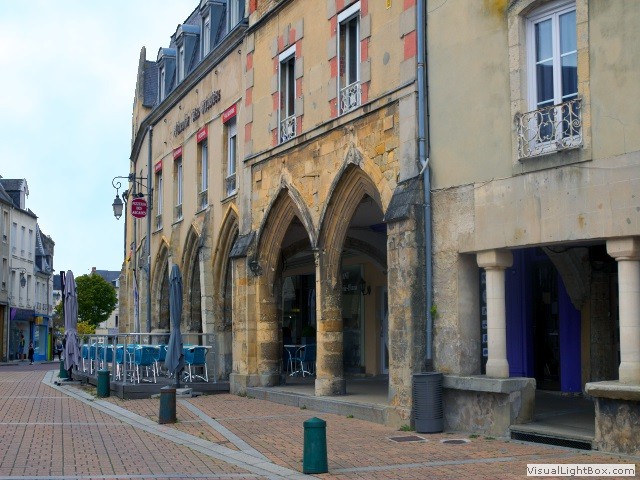 It's another twelve miles to Carenten les Maris my stop for tonight. The small
town is divided in half by 'Le canal de Carentan à la mer' and has two rivers
circumnavigating the town, on the other side of these rivers is marshland with few roads. Carentan
was defended by two battalions of the German Fallschirmjäger-Regiment no.6 and the 17th SS Panzer
grenadier Division. The tank division was ordered to the D-Day area; however, it was delayed by
shortages of trucks and attacks by Allied aircraft destroying the bridges over the rivers, so the
tanks stayed around Carenten hampering the Allied attack. Due to the topography of the town the
Allies were unable to bring armoured vehicles or big guns to fight. The combat was ferocious with
the Germans well dug in, the fight became hand to hand and street to street (hence the background
for the game), but it only took five days to take the town. The German forces became cut off from
reinforcements and were forced to withdraw on 12th June due to a lack of ammunition and fuel. After
check in at the 'l'Escapade hotel' I went for a walk, Carenten is beautiful medieval town, but
desolate early evening, there wasn't a sole around.
It's another twelve miles to Carenten les Maris my stop for tonight. The small
town is divided in half by 'Le canal de Carentan à la mer' and has two rivers
circumnavigating the town, on the other side of these rivers is marshland with few roads. Carentan
was defended by two battalions of the German Fallschirmjäger-Regiment no.6 and the 17th SS Panzer
grenadier Division. The tank division was ordered to the D-Day area; however, it was delayed by
shortages of trucks and attacks by Allied aircraft destroying the bridges over the rivers, so the
tanks stayed around Carenten hampering the Allied attack. Due to the topography of the town the
Allies were unable to bring armoured vehicles or big guns to fight. The combat was ferocious with
the Germans well dug in, the fight became hand to hand and street to street (hence the background
for the game), but it only took five days to take the town. The German forces became cut off from
reinforcements and were forced to withdraw on 12th June due to a lack of ammunition and fuel. After
check in at the 'l'Escapade hotel' I went for a walk, Carenten is beautiful medieval town, but
desolate early evening, there wasn't a sole around.
Day 6- Carentan to Quinéville (30 miles)
 Today, I will be zig-zagging to the coast and back inland then back to the coast, it's less
miles today, but it's going to be a longer day. I left Carentan and headed north, just before
Saint-Côme-du-Mont is Dead Man's Corner Museum. I've actually lost count of the museums I've
either passed or visited, by the sixth day I have museum fatigue, but this museum didn't let
me down. Dead Man's Corner Museum is in two parts, the house was the German paratroopers
Headquarters, until it was taken over by the American paratroopers. The museum got it's name
from the villagers believing it to be haunted such was the loss of life in and around the house.
I woundn't want to spend the night there with the creepy dioramas inside. The second part of the
museum is housed in a new building and houses a genuine C-47 aeroplane. The exhibition is well
laid out and very informative. The displays and portraits are very thought
Today, I will be zig-zagging to the coast and back inland then back to the coast, it's less
miles today, but it's going to be a longer day. I left Carentan and headed north, just before
Saint-Côme-du-Mont is Dead Man's Corner Museum. I've actually lost count of the museums I've
either passed or visited, by the sixth day I have museum fatigue, but this museum didn't let
me down. Dead Man's Corner Museum is in two parts, the house was the German paratroopers
Headquarters, until it was taken over by the American paratroopers. The museum got it's name
from the villagers believing it to be haunted such was the loss of life in and around the house.
I woundn't want to spend the night there with the creepy dioramas inside. The second part of the
museum is housed in a new building and houses a genuine C-47 aeroplane. The exhibition is well
laid out and very informative. The displays and portraits are very thought
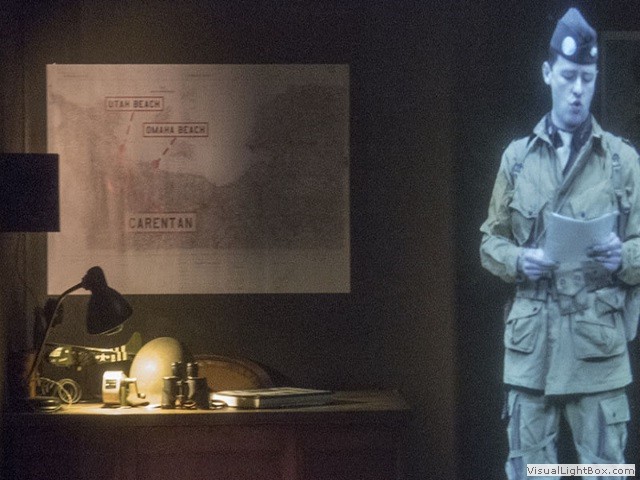 provoking, but the real treat is a flight simulation of the C-47 landing in the fields
nearby. We sat in a briefing room and was instructed by a ghost like holographic officer, then we
boarded the plane. The windows had LCD screens fitted and as flack exploded outside the
plane dropped, ducked and dived and then recovered, then we landed in a field. As a lay
person the sound, images and motion is as near as I'm going to get to the real thing, but
it was expensive.
provoking, but the real treat is a flight simulation of the C-47 landing in the fields
nearby. We sat in a briefing room and was instructed by a ghost like holographic officer, then we
boarded the plane. The windows had LCD screens fitted and as flack exploded outside the
plane dropped, ducked and dived and then recovered, then we landed in a field. As a lay
person the sound, images and motion is as near as I'm going to get to the real thing, but
it was expensive.
Onto 'Musée du Débarquement de Utah Beach' the place was teaming with people, but most
just wanted to see the beach. There was a landing craft with three soldiers in a line running
off the beach, people smiled and posed having their photos taken with the sculpture, but many
failed to see the significance of the men. They were in line because the first person was
shielding the one behind him, when he fell, the next would shield the others behind from
machine gun fire. I entered the Musée du Débarquement de Utah Beach, each museum I had visited
now blended with the others. What stood out from this one was a full size B26 Marauder
aeroplane and an interactive day by day diary of D-Day projected onto a 3D map. Riding parallel
along the Utah beach was some more bunkers, but these were deserted, too far away from
the main parking lot for the tourists to ogle at. Now, it was inland and you could see
how the terrain hindered the tanks and ground forces, large deep ditches ran perpendicular
to the roads and on the other side was marshland. D-Day minus 4 hours, the buildings in Sainte-Mère-Église
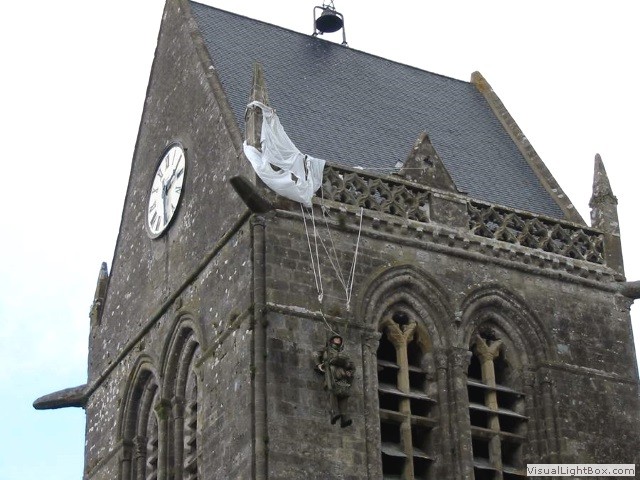 were on fire from Allied incendiary's and with the full moon it illuminated the sky, making easy targets of the
descending American paratroopers. Some were sucked into the fires, many landed in trees or hung
from utility poles and were shot before they could be cut loose. A well-known incident
involved paratrooper John Steele of the 505th Parachute Infantry Regiment, his parachute
caught on the spire of the town church (click image for better view), he could only observe the fighting continuing
below. He hung there limply pretending to be dead for two hours until captured by the Germans.
were on fire from Allied incendiary's and with the full moon it illuminated the sky, making easy targets of the
descending American paratroopers. Some were sucked into the fires, many landed in trees or hung
from utility poles and were shot before they could be cut loose. A well-known incident
involved paratrooper John Steele of the 505th Parachute Infantry Regiment, his parachute
caught on the spire of the town church (click image for better view), he could only observe the fighting continuing
below. He hung there limply pretending to be dead for two hours until captured by the Germans.
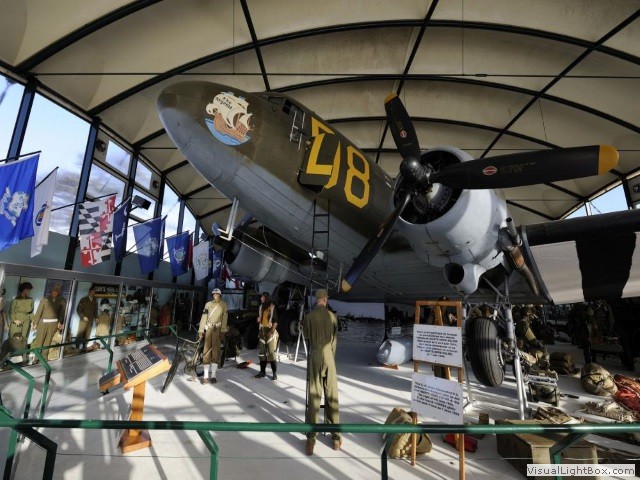 I entered Sainte-Mère-Église to visit the Airborne Museum (Musée Airborne) near the very church he
landed on. A friend suggested this was a must see, but allow more time than you think, the museum
has several buildings shaped like a parachute with a different themes in each. You're given a tablet
which provides information on each display. The intact glider and Dakota exhibits were the best I've
seen. In one building you enter a glider as a small group, you're plunged into darkness, and the sounds
simulate the famous air drops by the 82nd and 101st Airborne Division. When leaving the glider there's a
blast of wind, where we walk onto a
clear glass walkway where there's other paratroopers in the air
below, it gave the illusion of jumping from the plane.
I entered Sainte-Mère-Église to visit the Airborne Museum (Musée Airborne) near the very church he
landed on. A friend suggested this was a must see, but allow more time than you think, the museum
has several buildings shaped like a parachute with a different themes in each. You're given a tablet
which provides information on each display. The intact glider and Dakota exhibits were the best I've
seen. In one building you enter a glider as a small group, you're plunged into darkness, and the sounds
simulate the famous air drops by the 82nd and 101st Airborne Division. When leaving the glider there's a
blast of wind, where we walk onto a
clear glass walkway where there's other paratroopers in the air
below, it gave the illusion of jumping from the plane.
Heading north towards the beach I came across the Batterie d'Azeville, disguised by the Germans to look like a Norman cottage, the Azeville battery with its four Schneider cannons proved a mighty challenge for the Allied expeditionary force. The battery was finally taken on 9th June after bombardment by the USS Nevada; it's still possible to see where a shell burst straight through the bunker without detonating. You can explore more than 1,000ft of underground passages with a personal audio device. There's no actual exhibits, but the bunkers do have images on some of the walls.
It's onto the Batteries de Crisbecq an incredible mass of concrete; you can see the semi-collapsed
battery equipped with a preserved gun. There's a nice museum describing the history of the battery.
This is a private museum and mercifully the staff switched to English, but at €9 it's expensive.
OMG the last museum today at Quinéville. Fortunately, it revitalised my enthusiasm, it had an impressive full size village street set during the occupation, this was the first museum I've seen that incorporated a French resistance (Free French) scene. The museum actually backs onto part of the Atlantic Wall and quite unexpectedly you walk into an original bunker. This is my penultimate day and I felt it only right
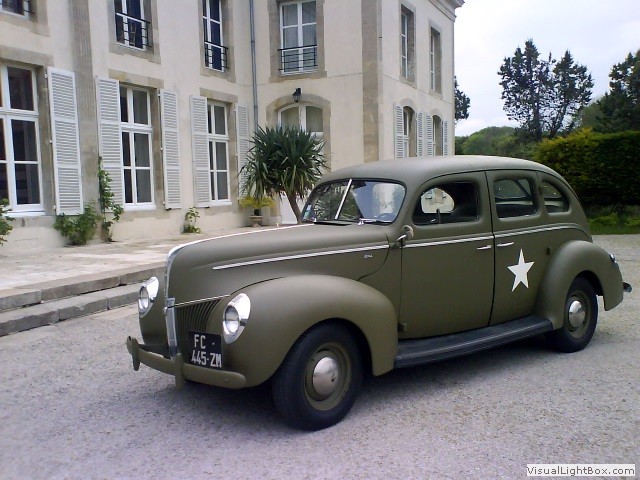 to stay at an iconic French building; a chateau, le Chateau de Quinéville, but even before I dropped
down the lane to the house, there was another massive bunker with a sighting tower. During the Second
World War the Chateau was requisitioned by the German army, accommodating their high ranking staff. In
1942, Marshal Rommel, Hermann Goering, and Joseph Goebbels stayed there during the inspection of the
Atlantic Wall. For more hidden gems on this day, have a look at the Gallery.
to stay at an iconic French building; a chateau, le Chateau de Quinéville, but even before I dropped
down the lane to the house, there was another massive bunker with a sighting tower. During the Second
World War the Chateau was requisitioned by the German army, accommodating their high ranking staff. In
1942, Marshal Rommel, Hermann Goering, and Joseph Goebbels stayed there during the inspection of the
Atlantic Wall. For more hidden gems on this day, have a look at the Gallery.
Day 7- Quinéville to Cherbourg (29 miles)
No rush today, down past La Sinope marina and along the beach front roads, after three miles
it's a little walk to the next beach road. I can taste the salty air on the breeze, compared to the
previous days, hectic, full of tourists, this untarnished route is off the beaten
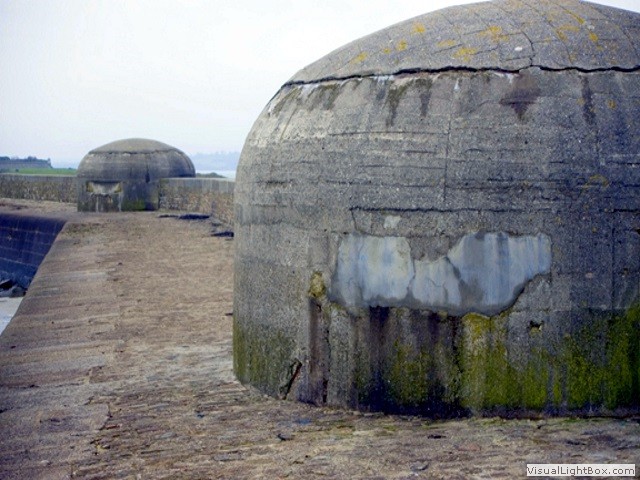 track. I left the beach road and crossed an old railway line at Beauvias, turning west at Quettehou
on the D1 heading for Saint Vaast-La-Hugue. Its out on the 'Route de La Hougue' causeway to 'Tour
Vauban de La Hougue'. I read the warning notice in French about not tackling the causeway if the sea
was rough (it was repeated in English but in very small lettering). The Tower of the Hougue was built
around 1694, for a different war; 'the hundred year war', but it was used in WW2 and the Germans built
a blockhouse.
track. I left the beach road and crossed an old railway line at Beauvias, turning west at Quettehou
on the D1 heading for Saint Vaast-La-Hugue. Its out on the 'Route de La Hougue' causeway to 'Tour
Vauban de La Hougue'. I read the warning notice in French about not tackling the causeway if the sea
was rough (it was repeated in English but in very small lettering). The Tower of the Hougue was built
around 1694, for a different war; 'the hundred year war', but it was used in WW2 and the Germans built
a blockhouse.
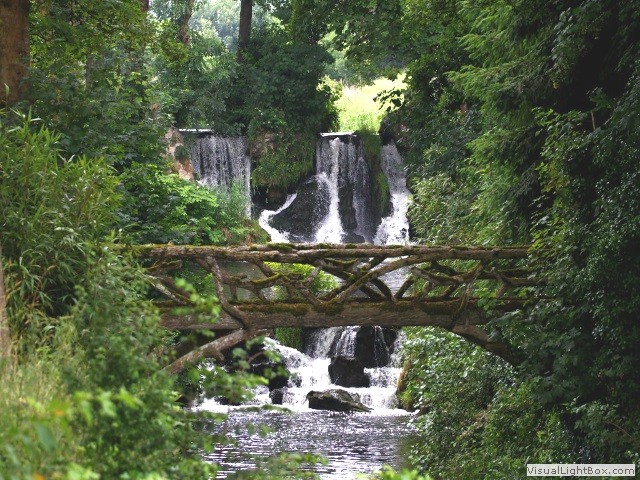 I left the port on the Route de Pierrepont then onto the D26 to 'Le Vast', here is a
fantastic waterfall which can be seen from the bridge crossing La Saire river (Cascades de la Saire)
in the grounds of the Château De La Germonière. It's now pretty much climbing through a lovely wooded
valley, but the best views are looking back. Just before the brow of the decent into Cherbourg was
Batterie Brommy (Les Caplains), built on an old French fort. Today the casemates are forgotten except
for the local graffiti artists. Soon I descended to the outskirts of Cherbourg, heading
for the marina and my stop for tonight- the Ambassadeur Hotel. All the local towns on route to
Cherbourg had embraced the D-Day anniversary with shop decorations and town fairs organised.
Walking around Cherbourg the city appeared unperturbed, I guess their liberation was sometime
after D-Day, it doesn't have the same meaning. The evening was better weather than earlier and
I walked around the port sighting a tall ship I saw on the second day at Canal de Caen à la Mer.
I left the port on the Route de Pierrepont then onto the D26 to 'Le Vast', here is a
fantastic waterfall which can be seen from the bridge crossing La Saire river (Cascades de la Saire)
in the grounds of the Château De La Germonière. It's now pretty much climbing through a lovely wooded
valley, but the best views are looking back. Just before the brow of the decent into Cherbourg was
Batterie Brommy (Les Caplains), built on an old French fort. Today the casemates are forgotten except
for the local graffiti artists. Soon I descended to the outskirts of Cherbourg, heading
for the marina and my stop for tonight- the Ambassadeur Hotel. All the local towns on route to
Cherbourg had embraced the D-Day anniversary with shop decorations and town fairs organised.
Walking around Cherbourg the city appeared unperturbed, I guess their liberation was sometime
after D-Day, it doesn't have the same meaning. The evening was better weather than earlier and
I walked around the port sighting a tall ship I saw on the second day at Canal de Caen à la Mer.
Day 8- Cherbourg to Portsmouth (ferry)
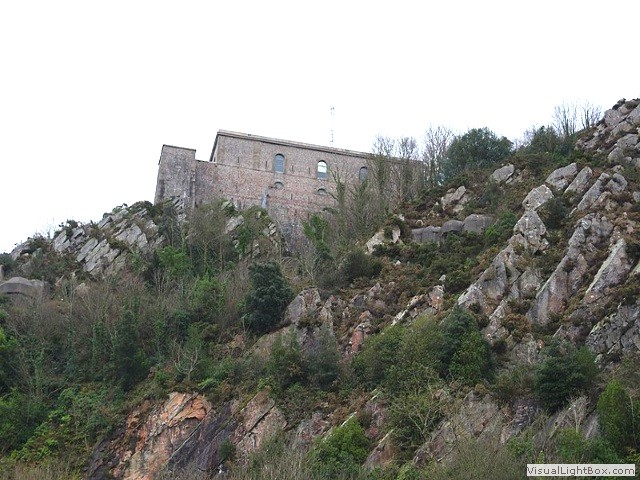 The hotel allowed me to leave the panniers behind for the day, my ferry back, to Blighty was at 1600. It was absolutely tipping down, but I wanted to see Batterie Du Roule and the Liberation Museum. I read the tripadvisor© review and everyone said the museums were worth a visit but get a taxi- I was tempted. So pouring down with rain I rode up a huge hill, with several hairpins. Halfway was Batterie Du Roule, it was closed, then there was the museum at the top of the hill- that was closed too. Incidentally there was a British chap who had also ridden up the hill. Even in the rain it was a tremendous view of Cherbourg. I coasted back down to last nights hotel to pick up my bags and then had a nice dinner in the harbour cafe.
The hotel allowed me to leave the panniers behind for the day, my ferry back, to Blighty was at 1600. It was absolutely tipping down, but I wanted to see Batterie Du Roule and the Liberation Museum. I read the tripadvisor© review and everyone said the museums were worth a visit but get a taxi- I was tempted. So pouring down with rain I rode up a huge hill, with several hairpins. Halfway was Batterie Du Roule, it was closed, then there was the museum at the top of the hill- that was closed too. Incidentally there was a British chap who had also ridden up the hill. Even in the rain it was a tremendous view of Cherbourg. I coasted back down to last nights hotel to pick up my bags and then had a nice dinner in the harbour cafe.
The ferry operators make cyclists wait in line for the ferry with cars, subsequently we were all drenched and glad to get aboard. This ferry was a fast one, so I expected a rough crossing, we left on time and sailed past a number of napoleonic forts, the biggest was Al largo di Cherbourg, these were converted into blockhouses by the Germans. They were only to stop small boat attacks on the harbour and were easily taken over by the Allies. The crossing was smooth contrary to what I first thought, as we approached Southampton there were hundreds of ships anchored, waiting to go into port. It was reminiscent of the night before D-Day, we had come around a full circle.
Addendum
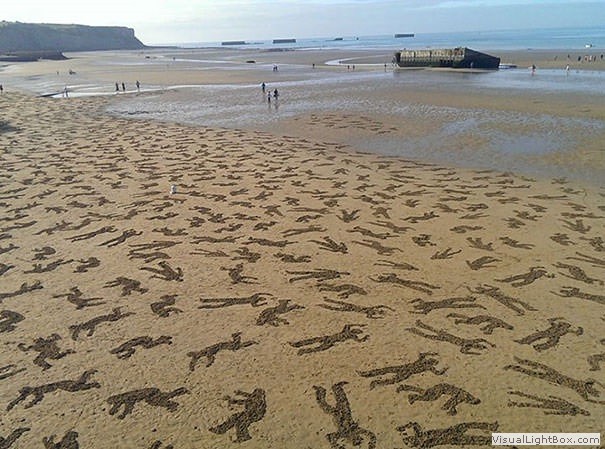 It's been an eye opener, operation Overlord has turned into a business (click image more more). Though the area could
easily stand alone as a tourist destination, the D-Day tourists contribute a massive amount to the
Normandy economy. There seems there's no compromise with French customs- they still shut businesses between
midday and 1400 (even though the weather in Normandy doesn't warrant it). A lot of the D-Day tourists are
English speaking and almost all museums are privately owned and in fairness, most accommodate
the tourists, and though it sounds daft; some do not. There are now so many museums, one
really has to selective to which ones you go to. I've discovered it's extremely difficult to
get an accurate ranking, even on 'Tripadvisor ©' you'd be lucky to get a negative
comment, but they can't all be great! Some used fashion manikins which didn't really add
to the authenticity of the exhibits, one even had velcro stuck on a manikin as a moustache.
It's been an eye opener, operation Overlord has turned into a business (click image more more). Though the area could
easily stand alone as a tourist destination, the D-Day tourists contribute a massive amount to the
Normandy economy. There seems there's no compromise with French customs- they still shut businesses between
midday and 1400 (even though the weather in Normandy doesn't warrant it). A lot of the D-Day tourists are
English speaking and almost all museums are privately owned and in fairness, most accommodate
the tourists, and though it sounds daft; some do not. There are now so many museums, one
really has to selective to which ones you go to. I've discovered it's extremely difficult to
get an accurate ranking, even on 'Tripadvisor ©' you'd be lucky to get a negative
comment, but they can't all be great! Some used fashion manikins which didn't really add
to the authenticity of the exhibits, one even had velcro stuck on a manikin as a moustache.
The hotels are very reasonably priced (that is if you stay away from the chains), even my 'Chateau de Quinéville' was only £70 an absolute bargain compared to the UK. Safety wise, I never felt threatened, but I was constantly aware of locking the bike in a secure place, if I couldn't find a place I was happy with, quite simply; I didn't go in. I love conspiracy theories and there's still one raging about 'La Pointe du Hoc' and 'Maisy Battery', I've just finished reading the book about it. Much of the area I rode along was quiet virtually flat farm roads, and even on the main roads the French are amazingly courteous to cyclists and always have been. There was only one car that came too close to me in nine days- incredible! The journey has been enlightening one and as promised; it has certainly been a roller coaster of emotions. Normandy will always be intertwined with the legacy of 1944, and the story is fascinating, but I don't confess to be an historical authority on D-Day, so please put any inaccuracies down to poetic license. I've raced in France loads of times, but I've never been to Normandy and I loved it. What an incredible journey!
-
Gallery (Day 5)
 Why not have a look at the gallery relating to this ride. Click the image or the title.
Why not have a look at the gallery relating to this ride. Click the image or the title. -
Quartermaster Graves Registration
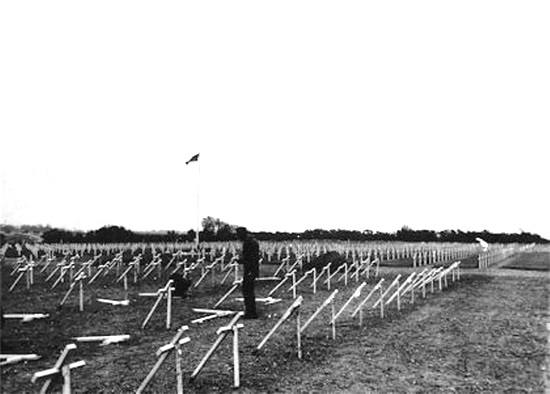 As macabre and grisly as it sounds there
were several platoons of the Quartermaster Graves Registration Company responsible for
cataloguing and burying the deceased soldiers on D-Day. They landed during and shortly
after the combat troops and sustained hundreds of casualties themselves. The platoons
then travelled east alongside the fighting soldiers.
As macabre and grisly as it sounds there
were several platoons of the Quartermaster Graves Registration Company responsible for
cataloguing and burying the deceased soldiers on D-Day. They landed during and shortly
after the combat troops and sustained hundreds of casualties themselves. The platoons
then travelled east alongside the fighting soldiers. -
Saving Private Ryan
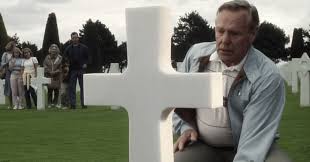 The opening sequence of Steven Spielberg's film Saving Private Ryan
was filmed at the Cimetière Américain de Normandie. The film draws on the story
of an actual soldier named Fritz Niland and a U.S. War
Department 'sole-survivor' directive designed to keep families from losing every one
of their sons.
The opening sequence of Steven Spielberg's film Saving Private Ryan
was filmed at the Cimetière Américain de Normandie. The film draws on the story
of an actual soldier named Fritz Niland and a U.S. War
Department 'sole-survivor' directive designed to keep families from losing every one
of their sons. -
Widerstandsnest 61
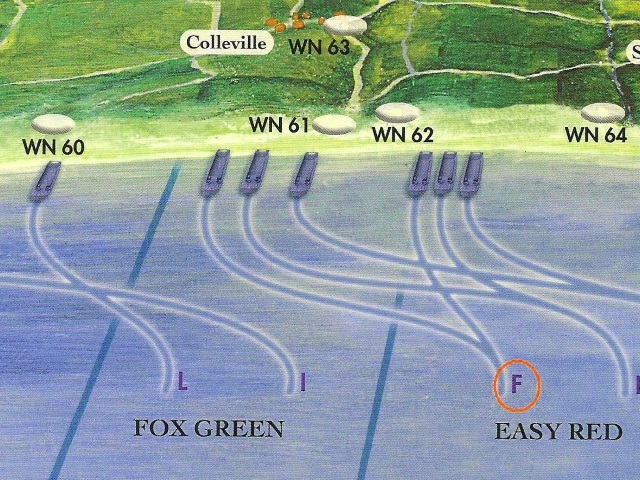 Wn61 and Wn62 were German gun emplacements responsible for the heavy casualties inflicted
during the first waves Americans that landed at Omaha beach. Click the image for more.
Wn61 and Wn62 were German gun emplacements responsible for the heavy casualties inflicted
during the first waves Americans that landed at Omaha beach. Click the image for more. -
La Pointe Du Hoc
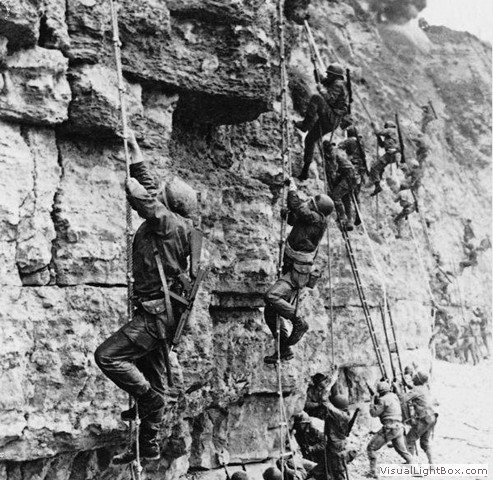 The Rangers were given the task of scaling the cliffs only to find the big guns weren't there and
were replaced by telegraph poles.
The Rangers were given the task of scaling the cliffs only to find the big guns weren't there and
were replaced by telegraph poles. -
'Warts and all' of Maisy Battery
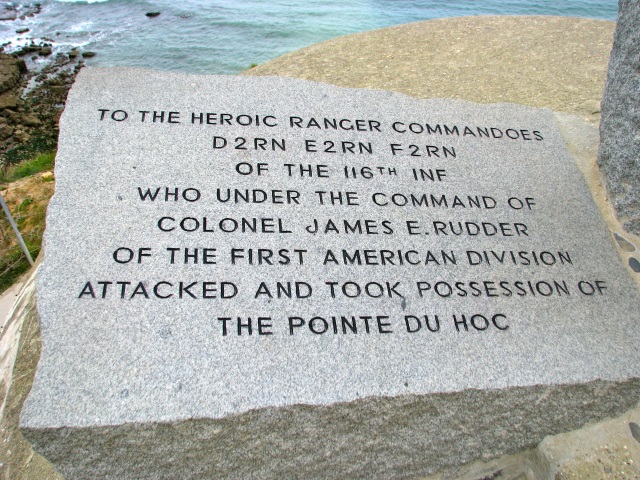 History is a continuing dialogue, between the
present and the past (click the image for larger view). Interpretations of the past are
subject to change in response to new evidence, new questions asked of the evidence, new perspectives
gained by the passage of time. There is no single, eternal, and immutable truth about past events
and their meaning. Those that were lost, are still lost, but respect for them is everlasting.
History is a continuing dialogue, between the
present and the past (click the image for larger view). Interpretations of the past are
subject to change in response to new evidence, new questions asked of the evidence, new perspectives
gained by the passage of time. There is no single, eternal, and immutable truth about past events
and their meaning. Those that were lost, are still lost, but respect for them is everlasting. -
Call of Duty Carentan
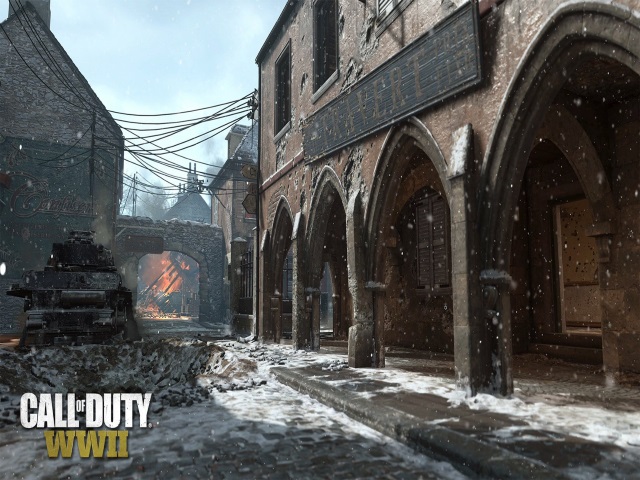 'The Call of Duty' war game was loosely based on the 'Battle of Carenten', such was
the vicious conflict to take the town. German troops were ordered to hold their positions
at all costs. American and German soldiers were so close to each other that they could
hear their enemy speak and cock their weapons. Under the cover of a smoke screen the
Americans moved forward and charged furiously with fixed bayonets and fought hand to hand.
'The Call of Duty' war game was loosely based on the 'Battle of Carenten', such was
the vicious conflict to take the town. German troops were ordered to hold their positions
at all costs. American and German soldiers were so close to each other that they could
hear their enemy speak and cock their weapons. Under the cover of a smoke screen the
Americans moved forward and charged furiously with fixed bayonets and fought hand to hand. -
Gallery (Day 6)
 Why not have a look at the gallery relating to this ride. Click the image or the title.
Why not have a look at the gallery relating to this ride. Click the image or the title. -
Filthy Thirteen
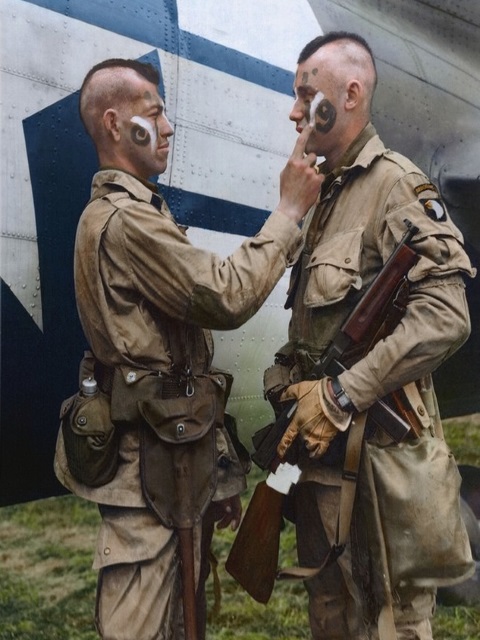 The 1st Demolition Section of the 101st Airborne Division were dropped behind
enemy lines to disable specific targets. The unit acquired the nickname the Filthy
Thirteen while living in Nissen huts in England inspiring the film 'the dirty dozen'.
Their signature appearance was mohican haircuts and war paint.
The 1st Demolition Section of the 101st Airborne Division were dropped behind
enemy lines to disable specific targets. The unit acquired the nickname the Filthy
Thirteen while living in Nissen huts in England inspiring the film 'the dirty dozen'.
Their signature appearance was mohican haircuts and war paint. -
Higgins boat Memorial
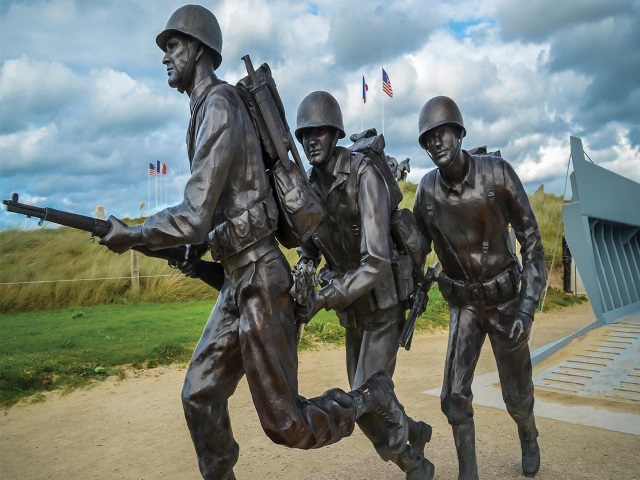 Running from the boat are sculptures by Fred Hoppe depicting a soldier from each of the
three wars in which Higgins Boats served (WWII, the Korean, and Vietnam War). The
Higgins boat was used for several landings prior to Normandy including North Africa,
Italy, southern France, and the Pacific theatre. Click the image for larger view.
Running from the boat are sculptures by Fred Hoppe depicting a soldier from each of the
three wars in which Higgins Boats served (WWII, the Korean, and Vietnam War). The
Higgins boat was used for several landings prior to Normandy including North Africa,
Italy, southern France, and the Pacific theatre. Click the image for larger view. -
Operation Titanic
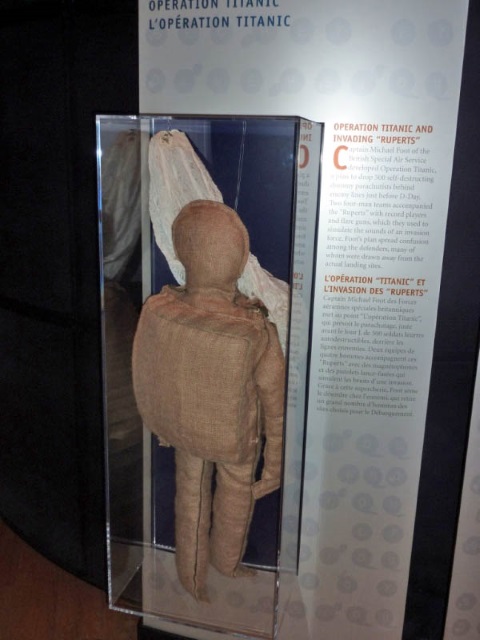 Hundreds of dummy paratroopers were dropped many miles east of Sainte-Mère-Eglise to lure
German fire power away from the real drop zone. The dummies in 'the Longest day' film were
much more elaborate than the real ones used in 1944, including fireworks to simulate gun fire.
Hundreds of dummy paratroopers were dropped many miles east of Sainte-Mère-Eglise to lure
German fire power away from the real drop zone. The dummies in 'the Longest day' film were
much more elaborate than the real ones used in 1944, including fireworks to simulate gun fire. -
Sainte-Mère-Église pump
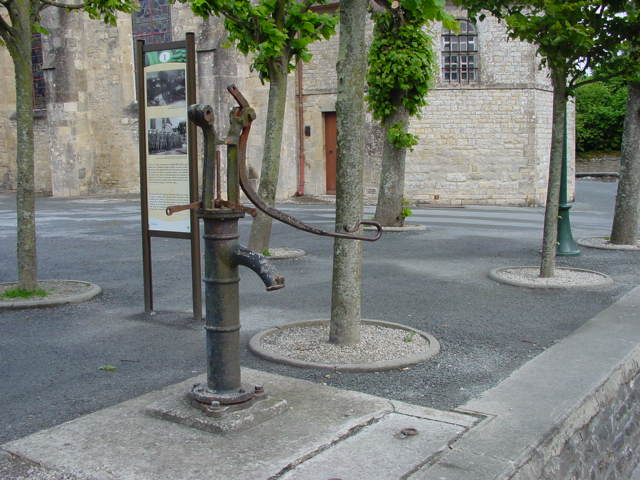 The panic in Sainte-Mère-Église was compounded because a house was on
fire in the town square. While the parachutists came down, the population stood in a line with buckets of
water to extinguish the fire. Can you believe the town pump is now a national monument?
The panic in Sainte-Mère-Église was compounded because a house was on
fire in the town square. While the parachutists came down, the population stood in a line with buckets of
water to extinguish the fire. Can you believe the town pump is now a national monument? -
The Nevada's Penatrating Shot
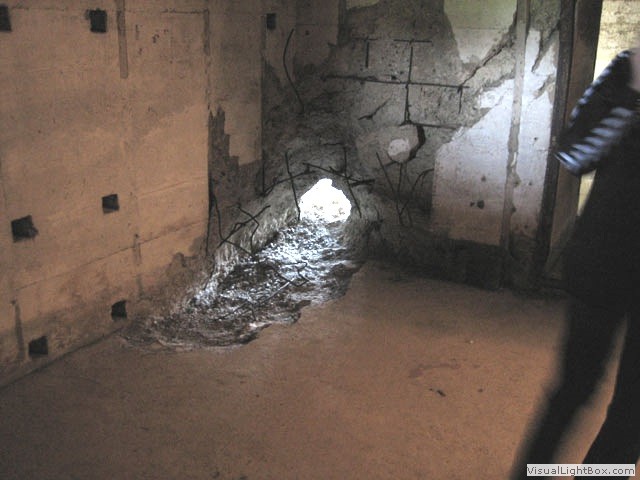 Azeville Battery was one of the Allies early targets. On the night of 9th June, a
14-inch shell from the USS Nevada heavily damaged one of the battery's four
case-mates, but failed to go off. Though the twisted shrapnel and concrete shards killed
all the Germans in this bunker. There the bomb lay buried for decades, until it was excavated
and safely detonated.
Azeville Battery was one of the Allies early targets. On the night of 9th June, a
14-inch shell from the USS Nevada heavily damaged one of the battery's four
case-mates, but failed to go off. Though the twisted shrapnel and concrete shards killed
all the Germans in this bunker. There the bomb lay buried for decades, until it was excavated
and safely detonated. -
Victor Lundy's sketches
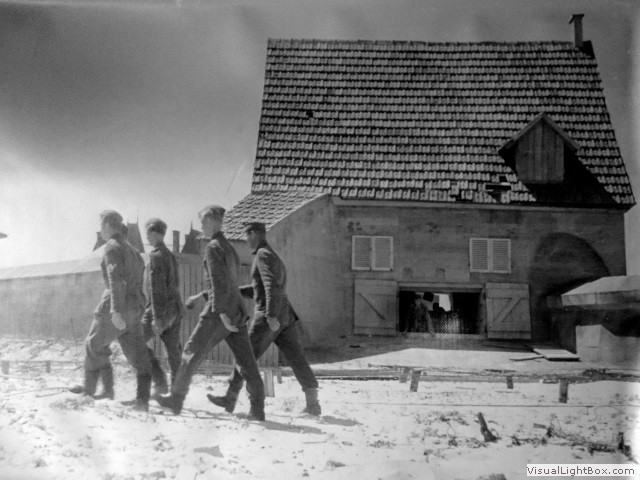 You have got to visit Quinéville museum, it is well worth it.
Victor Alfred Lundy was 21 years old when he was shipped out to Europe. D-Day and
the army had changed his plans from architecture, to the infantry, but his drawing
skills came in useful (click the image to see his sketch of the gun) as he illustrated
his journey from training to D-Day and beyond.
You have got to visit Quinéville museum, it is well worth it.
Victor Alfred Lundy was 21 years old when he was shipped out to Europe. D-Day and
the army had changed his plans from architecture, to the infantry, but his drawing
skills came in useful (click the image to see his sketch of the gun) as he illustrated
his journey from training to D-Day and beyond. -
Gallery (Day 7)
 Why not have a look at the gallery relating to this ride. Click the image or the title.
Why not have a look at the gallery relating to this ride. Click the image or the title. -
French whaling
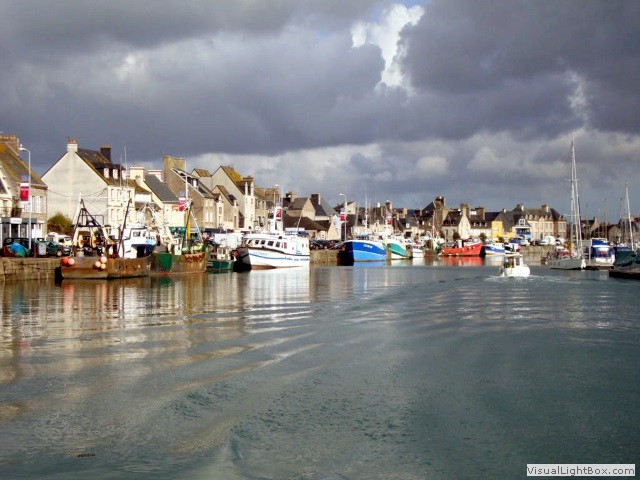 Saint-Vaast-la-Hougue was a very active whaling center, as there was a dense population
of the then common Gray Whale (which is now extinct in the Atlantic). Now the Northwest passage
is ice-free, perhaps they will breed off Saint-Vaast-la-Hougue once more.
Saint-Vaast-la-Hougue was a very active whaling center, as there was a dense population
of the then common Gray Whale (which is now extinct in the Atlantic). Now the Northwest passage
is ice-free, perhaps they will breed off Saint-Vaast-la-Hougue once more. -
Batterie Brommy
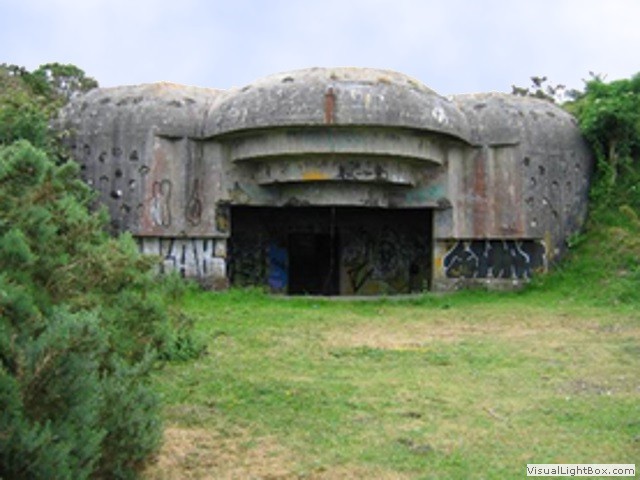 On June 25th, the battery was bombed by a swarm of P-47s, soon after the
American infantry began moving up the hill. A white flag was hoisted on one of the battery's casemates, but
the other two batteries opened fire with mortars. With the help of Sherman tanks the battery
was eventually taken, and 400 Germans were captured.
On June 25th, the battery was bombed by a swarm of P-47s, soon after the
American infantry began moving up the hill. A white flag was hoisted on one of the battery's casemates, but
the other two batteries opened fire with mortars. With the help of Sherman tanks the battery
was eventually taken, and 400 Germans were captured. -
Gallery (Day 8)
 Why not have a look at the gallery relating to this ride. Click the image or the title.
Why not have a look at the gallery relating to this ride. Click the image or the title. -
Batterie Du Roule
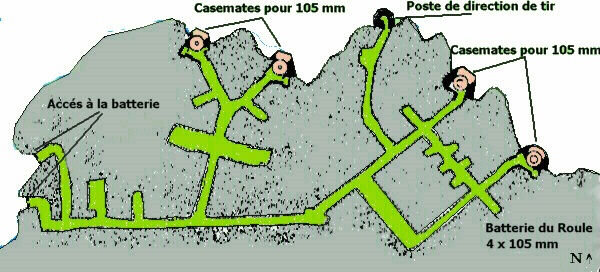 The Todt organization (Third Reich military engineering group) pierced several
tunnels into the mountain and installed casemates for artillery to protect the
harbour. The saying is 'whoever owns the Roule, owns Cherbourg'.
The Todt organization (Third Reich military engineering group) pierced several
tunnels into the mountain and installed casemates for artillery to protect the
harbour. The saying is 'whoever owns the Roule, owns Cherbourg'. -
Lest we forget
Those surviving D-Day today would be in their nineties, for most, these people are likely to be fathers and grandfathers and on. My father didn't share his involvement in the war until he was very old, it was just too harrowing, I suspect most are the same. Walking on the invasion beaches didn't evoke feelings of great sadness or loss, because there are no visual triggers to upset you, the sea is clean not red with blood and there's no shock or disbelief that the friend lying next to you has been mortally wounded.
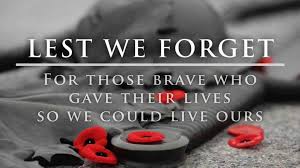
One has to tell yourself there was something very poignant and disturbing about Normandy, and immerse yourself walking in the footsteps of the fallen. Next week is the 75th anniversary of the D-Day landings, a reminder something very horrific happened many years ago, the events can not become ineffable- ever.